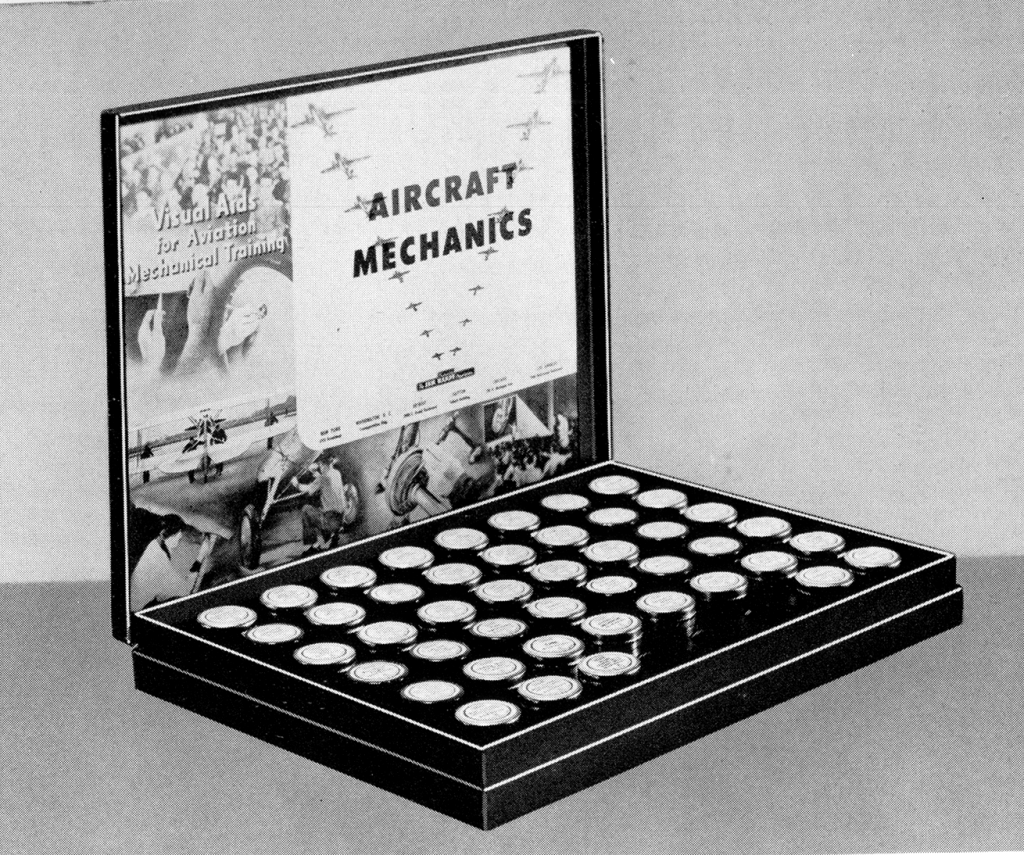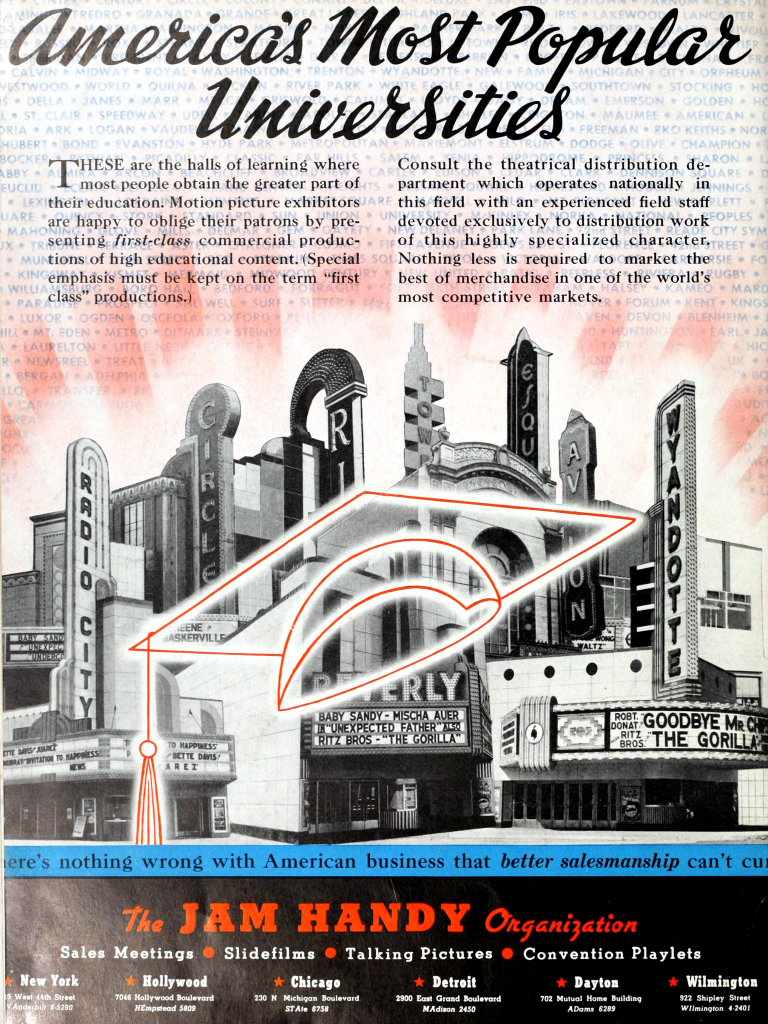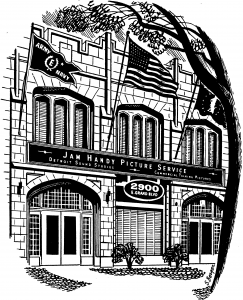THE JAM HANDY – A FILMMAKING ICON AND AMERICAN RELIC
By Jonathan Boschen
One iconic building tucked away in the city of Detroit MI is a performing arts center and art gallery called the Jam Handy, located at 2900 East Grand Boulevard. This Gothic-Revival structure is an iconic building, as it was utilized as a film production sound stage from the 1930s through the 1960s by a company called the Jam Handy Organization, which specialized in industrial films, filmstrips, and other AV aids, etc. The company, established in the early 1920s by Olympic Swimmer Jamison Handy, is historically significant to both American history and film history due to its role in developing the filmstrip medium, and creating industrial films and training films for General Motors and the United States Armed Forces. Today the building is one of the only remaining relics of the Jam Handy Organization and also Detroit’s once ambitious film industry, the largest to be located outside of Hollywood and New York City during the 1930s and into the 1960s.
2900 East Grand Boulevard was purchased by the Jam Handy Organization in 1935, however it’s history goes back to 1919. Originally the building was the Maranatha Baptist Tabernacle which was designed by Joseph E. Mills & Sons Architects, and through the 1920s and up to the 1930s was used as a place of worship. The purchase of the property in 1935 came about when Jamison Handy moved his company from Chicago to Detroit to be down the street from his main client, the General Motors Corporation. Handy’s production of filmstrips (a medium he perfected) and industrial films for General Motors previously saved their Chevrolet Division from failing, and were now currently assisting the various GM divisions in selling their products. The former tabernacle would be one of several buildings along Detroit’s East Grand Blvd., all built prior to 1935, that were purchased or rented by Jam Handy and then renovated to house the company’s various departments.
During it’s roll as the Jam Handy sound stages from 1935 to 1969, the building would be used for the production of thousands of sponsored motion pictures and filmstrips, and also as the recording space of the Jam Handy Orchestra. 2900 East Grand Boulevard would also become the building most associated with the company as it was frequently featured in Jam Handy’s trade ads. Hundreds of people including several very talented forgotten filmmakers like Rockwell Barnes, Frank Goldman, Gordon Avil, J. Cullen Landis and Pierre Mols, and musical director Samuel Benavie, worked in the building. All of the company’s films applied Jamison Handy’s philosophies on the presentation of educational media such as “learning should be a pleasure and not a pain in the head”. Thus their films featured extremely high production values, and were loaded with enthusiasm toward a product/idea. Filmstrips combined all types of nicely shot photographs some with enhanced effects, cartoon drawings, detailed accurate technical drawings, and appropriate mild use of text. The motion picture productions were equally as polished and often featured beautiful cinematography, a range of visual effects, cartoon animation, detailed technical animation, stop motion animation, triumphant and animated musical scores, narration that talked to the viewer, etc. In addition to making films, the company also specialized in creating special A/V training devices, such as their aerial gunnery trainers during World War II for the military, an early video game type device that used 16mm film to train airplane gunners in shooting down enemy aircraft.
Handy would receive numerous awards and honors from various organizations and also the United States Government. During World War II the company received several Army-Navy E awards for their mass production of military training films. (Several former employees have stated that the company was producing more film than the major Hollywood Studios!) The United States Government considered the films Jam Handy was producing extremely essential to the war front and even offered on several occasions to build Jam Handy new studios with tax payer money; an offer that was respectfully declined by Handy several times both during and after the war as he was not an opportunist. Other awards and honors came from various organizations, and even from the city of Detroit who Honored Mr. Handy and the company with a Jam Handy day on November 27, 1961.
What brought the end of the Jam Handy Organization, thus the eventual change of ownership of 2900 East Grand Boulevard were several issues and factors throughout the 1960s that would eventually end the company in the early 1970s. To be extremely brief, in 1969 Jamison Handy sold the 2900 East Grand Boulevard property as Jam Handy Productions to a New York based company called Teletape. Teletape would operate the facility as Jam Handy Productions until 1971 when it was renamed Teletape-Detroit. Teletape would use it as a film/video production facility for another few years, until for several reasons moved out of the building and put it on the market. It was eventually purchased by a church named Faith Through Miracles who used it throughout the 1990s and into the 2000’s to record their church services for local broadcast. The Church eventually ended up in financial distress and the building was acquired by the city of Detroit. The city put the property up for auction in 2010 where it was fortunately purchased by Simeon and Nat Hayer. Since then, Simeon has successfully converted the building into a performing arts space, and over the years has been restoring the building back to it’s former glory.
While the building may not be the most architecturally sophisticated building, like many of Detroits many factories and once grand theaters, it’s still a fascinating relic from a historically significant company and from the era of Detroit’s once bustling film industry. The author had the privilege of visiting and touring the building in 2016 while out in Detroit filming some interviews for his documentary on the Jam Handy Organization. Below are several pictures which show the space where several talented individuals created thousands of spectacular films.
The Jam Handy Arial Gunnery Trainer

A picture of one of Jam Handy’s WWII era ‘Arial Gunnery Trainers’. These early video game type devices used 16mm film that was synchronized with a gun device to train airplane gunners in shooting at Axis planes. Photo from the collection of the author.
Award Winning Company
Theater Advertisement Films

A movie theatre audience watches a Chevrolet sponsored film. Many of the sponsored theatrical short subjects created by the Jam Handy Organization utilized a subliminal advertising method that used only product placement. The films, which often used common interest themes which could be related to the product in some way (i.e. how our eyes allow us to see the color of a car) never make any audio references to the product itself. This technique allowed the films to be well received and regarded as typical entertaining short subjects by theatre audiences. Image from the collection of the Prelinger Archives.
Filmstrip Kits
Various Filmstrip Frames

Various frames from different Jam Handy 35mm Filmstrips produced for Chevrolet in the 1930s. These filmstrips, credited to helping keep General Motors afloat during the 1930s, are excellent examples of the types of filmstrips made by Jam Handy during the 1920s through the 1960s; a medium which Jam Handy perfected and popularized during this time. They relied mainly on pictures and uncluttered, appropriate use of text. All types of techniques, such as cartoon renditions of customer service signs coming to life, to small safety inspectors touring the inside of an automobile, were put to use to make the potentially boring material entertaining. Images from the collection of the author.

An image from a General Motors 35mm filmstrip. Several sources credit Jam Handy to saving the Chevrolet division of General Motors through the use of films. Image from the collection of the author.
Jamison Handy

1919 Press photo of Jamison Handy, taken shortly before starting his company that would become the Jam Handy Organization. Image from the collection of the Prelinger Archives.
The Direct Mass Selling Program

Film stills from several 1930s Chevrolet theatrical short subjects (that were created for the iconic Direct Mass Selling program in use from 1935 to 1941/2) which demonstrate the various filmmaking techniques applied to the films. Everything from special visual effects to cartoon animation was used in Jam Handy’s motion picture productions to make the educational films as fun as possible. Film stills from the collection of the Prelinger Archives.
Jam Handy Pocket Explainer

An advertisement image of the Jam Handy Pocket Explainer, from the late 1920s/early 1930s. This device is credited by the Society of Motion Picture and Television Engineers as being the very first filmstrip projector. Filmstrips utilized 35mm safety film, as oppose to the cheaper and more dangerous 35mm nitrate film. The device allowed a salesman to go door to door with a small piece of safety film, consisting of 50 to 100 still projected images, to show off and educate potential customers on their product. Image from the collection of the author.
Self Contained Under one Roof, with nothing outsourced!

WWII Filmstrip Kit

A World War II era filmstrip kit produced for the armed forces. Image from the collection of the author.

2900 East Grand Boulevard, as seen after its renovation from tabernacle to sound stage in 1935. Image from the collection of the Prelinger Archives.

A photo of 2900 East Grand Boulevard after it was sold to Teletape as Jam Handy Productions. Image from the collection of the Author.
Sponsored Films for Theaters

A Trade ad for the 1939 theatrical sponsored short film “More Power To You”, sponsored by Sun Oil Company, aka Sunoco. The film was narrated by Lowell Thomas who narrated many Jam Handy industrial films. Image from the collection of the Prelinger Archives.
America’s Most Popular Universities

A trade ad advertising Jam Handy’s production and distribution of sponsored films for theatrical distribution. Image from the collection of the Prelinger Archives.

World War II era trade ad for the Jam Handy Organization, after receiving the Army-Navy E Awards. The United States Government offered to rebuild Jam handy’s production facility with tax payer money, an offer that Handy respectfully declined several times. (Note the 2900 East Grand Boulevard Building in the right corner.) Image from the collection of the Prelinger Archives.

1950s era trade ad for the Jam Handy Organization; note the 2900 East Grand Boulevard building in the bottom left corner. Image from the collection of the Prelinger Archives.
First Animated Adaption of Rudolf The Red Nosed Reindeer

One of the Authors favorite Jam Handy films is the 1947 Technicolor animated adaption of “Rudolf the Red Nosed Reindeer”. The cartoon, a typical 10 minute theatrical cartoon, was sponsored by Montgomery Ward and directed by notable cartoonist Max Fleischer. This late-1950s Jam Handy Christmas Greeting trade ad for the cartoon shows Rudolf flying over 2900 East Grand Boulevard. Image from the collection of the Prelinger Archives.

A high resolution scan by the author, of the WWII era sketch of the 2900 East Grand Boulevard property. Image from the collection of the author.
Jam Handy Building Today
TWENTY GREAT JAM HANDY SHORT FILMS TO CHECK OUT:
“Auto-Lite On Parade”, 1940 (Electric Auto-Lite Company)
“No Ghosts”,1935 (Chevrolet-GM ‘Direct Mass Selling Program’)
“Down The Gasoline Trail”, 1936 (Chevrolet-GM ‘Direct Mass Selling Program’)
“How You See It”, 1936 (Chevrolet-GM ‘Direct Mass Selling Program’)
“The Master Hands”, 1936 (Chevrolet-GM ‘Direct Mass Selling Program’)
“A Coach For Cinderella”, 1936 (Chevrolet-GM ‘Direct Mass Selling Program’)
“From Dawn to Sunset”*, 1937 (Chevrolet-GM ‘Direct Mass Selling Program’)
“Hold Everything”*, 1937 (Chevrolet-GM)
“Helping You Sell”*, 1938 (Chevrolet-GM ‘Direct Mass Selling Program’)
“Color Harmony”, 1938 (Chevrolet-GM ‘Direct Mass Selling Program’)
“More Power To You”, 1939 (SUNOCO/Sun Oil Company)
“Refreshment Through The Years”, 1939 (Coca-Cola Company)
“Leave It to Roll-Oh”, 1940 (Chevrolet-GM ‘Direct Mass Selling Program’)
“Rudolf The Red Nosed Reindeer”, 1947 (Montgomery Ward)
“Just Imagine”, 1947 (Bell Telephone/AT&T)
“Millions of Masterpieces” 1950 (Chevrolet-GM)
“American Harvest”, 1956 (Chevrolet-GM)
“Aluminum on The March”, 1956 (Chevrolet-GM)
“American Engineer”, 1956 (Chevrolet-GM)
“The Ballad Of Soup Du Jour”, 1963 (Campbell Soup)
A special Thank you to Simeon Hayer, John Rusche, Bill Sandy, Ray Pointer, Rick Prelinger, Gil Kanat, Steve Stanchfield and Steve Young
Jonathan A. Boschen is a member of the Theatre Historical Society of America. While the vast majority of his free time has been devoted to researching movie theaters in Massachusetts, Vermont and New Hampshire, he has also spent a good amount of time researching the Jam Handy Organization and it’s contributions to American and Film History. He is currently working on a large scale documentary on the company.
If you find this story fascinating, we have a treasure trove of information about the history of your favorite theatres. Sign up for an account on historictheatres.org and enter through the STAGE DOOR!
For nearly fifty years Theatre Historical Society of America has been celebrating, documenting, and promoting the architectural, cultural, and social relevance of America’s historic theaters. However, we can’t do it alone. Support from cinema lovers, architects, historians and people like you are paramount to our success. Become a member today, and help us preserve the rich history of America’s greatest theatres.





